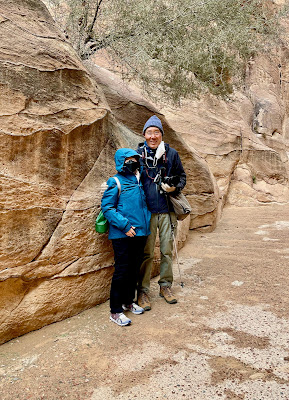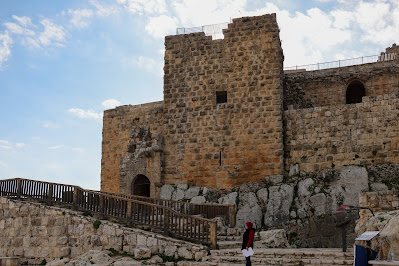Over the past 18 months of the pandemic, we didn't stray too far from our house. We rented vacation houses rather than visit hotels. We limited our restaurant outings to takeaway and just a few outdoor dining opportunities. With this trip, we re-entered the world of international travel, airports, hotel stays and indoor dining for breakfasts, lunches and dinners. This was quite a change up for us and seemed almost like a 'freeing' new experience.
What did this mean to me? It was a step away from COVID anxieties. It was a return to the enjoyment of socializing with fellow travelers over dining table conversations and exchanging perspectives on new sights, foods and experiences.
Nonetheless, COVID controls followed us wherever we traveled, but these were expected inconveniences. We were asked to wear face covers as we visited temples and tombs, walked through hotel interiors, transited to/from restaurants and as we selected buffet meal items in restaurant settings. Our coach driver just about always met us (actually, our hands) with a spray of blue sanitizer. Small prices to pay for a return to travel.
Amman, Jordan
In Jordan, our two major outings were to Jerash and Petra. Jerash is in northern Jordan, about 30 miles from Amman. Jerash is known for its eighth century Greek and Roman ruins but artifacts have been found from Neolithic settlements (7500-5000BC). Jerash is sometimes referred to as the "Pompeii of the East." The number of remaining structures was quite amazing given the age of this expansive historical area. Remaining structures included colonnaded streets, amphitheaters, oval forums, arches, a hippodrome and temples.
In 2018, about 330,000 visitors came to Jerash but the COVID pandemic severely decreased the current visitor counts throughout Jordan. There may have been 200 visitors at Jerash during our guided trip. Given the 160 acre size of Jerash, that's a little over one person per acre during our visit!
After lunch, we made a stop at Ajloun Castle, a 12th century castle, protecting regional trade and communication routes. Built on a monastery site, it was repurposed as a military castle by a general in Saladin's army. This general was an emir and Saladin's nephew.
There were many steps required to reach the castle upper towers and views of the Jordan valley from Mt. Ajloun.
Petra, Jordan
On the coach drive from Amman to Petra, we made a brief stop at Mt. Nebo. From the high elevation of Siyagha (2,300 feet above the Jordan Valley), Moses was said to have viewed the promised land. Some believe Moses may be buried on Mt. Nebo. In 1976, a Diakonikon-Baptistery mosaic from 530AD was found under the floor of the existing monastery. Note how the giraffe depicted in the mosaic looks more like a camel.
From Mt. Nebo, our coach continued towards the Dead Sea after making a brief stop at a mosaic workshop. The workshop was founded by the Queen Noor Foundation, to assist local artisans. We were able to observe the mosaic construction process and the visit ended in a vast showroom, with opportunities to purchase local handicrafts, from rugs, clothing, jewelry and, of course, mosaics.
The next coach stop was at the Crown Plaza - Dead See, for lunch and a chance to float on the salty Dead Sea. On this day, the weather conditions were extremely windy, with double red flags flying at the beach. This is the highest warning level for severe water conditions and water entry is prohibited. Although we couldn't enter the water to test our buoyancy, some of our fellow travelers slathered nearby black mud on their legs. This natural silt material is known for its cleansing and detoxification capabilities. The windy weather and growing dark clouds were an indication that sunny days were likely behind us.
After lunch, we continued out coach ride to Petra. The weather progressed from rain to heavy snow. The coach driver had to slowly make his way through poor visibility and increasing snow on the roadway. Soon after our coach reached the Movenpick Resort Petra in the early evening, the road we had just passed over was closed due to accumulated snow.
The next morning, we gathered at 9am, to start our walking tour of Petra. Although the snow and rain had stopped, we had to bundle in several clothes layers to keep warm in the cold and strong wind. I was glad I brought along a baselayer set on this trip.
Petra is the top tourist draw in Jordan. As you view the below images, note how few people were present during our visit. Photos from the 2022 summer tourist season are likely to reflect much larger visitor crowds.
As visitors enter Petra, there are a number of merchants pitching their items to tourists. Given the cold weather and my neglecting to pack a warm hat, I negotiated a $10 knit cap down to $5.
The most recognized stone carving in Petra is the 2,000 year old, Al-Khazneh, or "The Treasury." Some historians believe this was the mausoleum of Nabatean King Aretas IV. Others have suggested it was a library containing important scrolls of the time. The exterior intricate carvings and sculpture that remain are truly amazing to view. On the top are four eagles and the entrance is flanked by statues of Castor and Pollux, twins that resided on Olympus. One can only guess of the architectural details that have eroded over time.
Visitors are no longer permitted to enter this structure. There is one main chamber and three antechambers within the interior - each rather plain in detail. The lack of ornate room interiors has raised support for the idea that "The Treasury" was actually a library.
 |
| Bundled up for the cold with my new hat |
 |
| A Petra Visit Could Look Like This! Photo Courtesy of Roya News |
 |
| Petra is Often Used for Movie Locations |















No comments:
Post a Comment